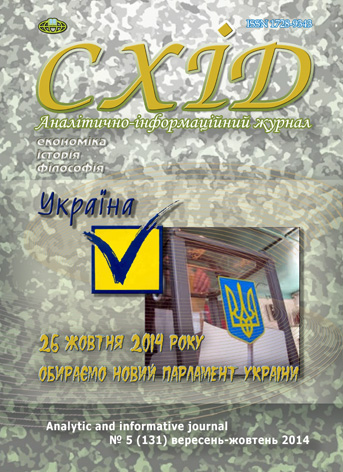The peculiarities of the social-right status of Polish people in Galicia in 1941-1944
DOI:
https://doi.org/10.21847/1728-9343.2014.5(131).29616Keywords:
Polish people, Galicia, German occupational system, social-right statusAbstract
An article analyzes the features of social and legal status of Poles in Galicia (Galychyna) in the context of everyday life the period of 1941 - 1944 years. Particular attention is drawn to the process of formation and competence of civil authorities, whose activities were aimed at establishing the total control over all people's spheres of life. Here was the need for the formation of branched occupation apparatus, which encompassed the political, social-economic, cultural and religious fields. Strict regime activities conducted by new authorities were also enlightened. The speech is about a curfew time, banning gatherings, meetings, inability for free rail travel and more. A significant role in that period is assigned to the existing moments of legitimatings, including permit and identity card for the new model. It was revealed the influence of German occupation policy on social-psychological characteristics of the Polish population, the dominant features of which became fear and rootless feeling. The last ones were formed under a strict policy of occupied authorities in the social sphere, which included numerous repressive measures, mass arrests, forced removal to work in Germany.
Downloads
References
Samostiina Ukraina (1941), July 9, p. 3 (ukr).
Kosyk V. (1993), Ukraine and Germany in World War II, Paris, New York, Lviv p. 659 (ukr).
Lemko I., Mykhalyk V. (2010), Lviv everyday (1939-1941), Lviv, p. 659 (ukr).
Lvivski visti (1941), 61, p. 3 (ukr).
German fascist occupation regime in Ukraine. Collection of documents and materials, (1963), Kyiv, p. 659 (ukr).
Ukrainske slovo (1941), July 29, p. 4 (ukr).
Ofitsynskyi V. (2001), Dystrykt Halychyna (1941-1944): Historical and political outline, Uzhhorod, p. 659 (ukr).
Rohatynske slovo (1941), August 2, p. 3 (ukr).
Kaluskyi holos (1942), February 8, p. 4 (ukr).
Ostanni visty (1941), November 23, p. 2 (ukr).
Ukrainske slovo (1941), August 15, p. 4 (ukr).
Central State Historical Archives of Ukraine in Lviv, fond 755, opys 1, sprava 9, 5 p. (ukr).
Central State Historical Archives of Ukraine in Lviv, fond 755, opys 1, sprava 11, 4 p. (ukr).
Central State Historical Archives of Ukraine in Lviv, fond 755, opys 1, sprava 368, 2 p. (ukr).
Central State Historical Archives of Ukraine in Lviv, fond 755, opys 1, sprava 10, 3 p. (ukr).
Central State Historical Archives of Ukraine in Lviv, fond 755, opys 1, sprava 357, 7 p. (ukr).
Central State Historical Archives of Ukraine in Lviv, fond 755, opys 1, sprava 18, 21 p. (ukr).
Central State Historical Archives of Ukraine in Lviv, fond 755, opys 1, sprava 4, 33 p. (ukr).
Central State Historical Archives of Ukraine in Lviv, fond 755, opys 1, sprava 367, 2 p. (ukr).
Central State Historical Archives of Ukraine in Lviv, fond 755, opys 1, sprava 16, 25 p. (ukr).
Slyvka Yu. (2005), Ukraine in World War II, the national political and international legal aspects, Lviv, p. 35. (ukr).
Central State Historical Archives of Ukraine in Lviv, fond 755, opys 1, sprava 15, 32 p. (ukr).
Kosyk V. (1997), Ukraine in World War II documents. Collection of German archival materials, Vol. 1, Lviv, p. 352 (ukr).
Central State Historical Archives of Ukraine in Lviv, fond 755, opys 1, sprava 108, 1 p. (ukr).
Central State Historical Archives of Ukraine in Lviv, fond 755, opys 1, sprava 371, 3 p. (ukr).
Bonusiak W. (1990), Małopolska Wschodnia pod rządami Trzeciej Rzeszy, Wydawnictwo Wyższej Szkoly Pedagogicznej w Rzeszowie, Rzeszόw, 264 s. (pol).
Brzeziński Z. Droga cierpienia. Tekst z protokołu przesłuchania świadka Czesława Hermana, available at: http://stanislawow.net/wspomnienia/herman_droga.htm. (pol).
Нryciuk G. (2000), Polacy we Lwowie, 1939-1944. Życie codzienne, Warszawa, 432 s. (pol).
Jastrzębski S. (2004), Ludobόjstwo ludności polskiej przez OUN – UPA w wojewόdztwie Stanisławowskim w latach 1939-1946, Wydawnictwo Archidiecezji Warszawskiej, Warszawa, 471 s. (pol).
Jordan М. (2000), Czarny Las pod Stanisławowem, Cracovia Leopolis, № 1, available at: http://stanislawow.net/publikacje/cracovia/czar_las.htm. (pol).
Kamiński T. (2002), Tajemnica Czarnego Lasu, Cracovia Leopolis, № 1, available at: http://www.Cracovia leopolis.pl/index.php?pokaz=publikacje&id=199&rok=2002. (pol).
Krajewski T. Losy Stanisławowa i jego mieszkańców na tle historii, available at: http://stanislawownet/wspomnienia /losy_stanislawowa.htm. (pol).
Madajczyk Cz. (1970), Polityka III Rzeszy w okupowanej Polsce, T. 1, Państwowe Wydaw. Naukowe, Warszawa, 664 s. (pol).
Olszański T. (2008), Kresy kresów – Stanisławów, Wydawnictwo “Iskry”, Warszawa, 175 s. (pol).
Wierzejski L. (1991), Krwawa karta z najnowszych dziejów Stanisławowa, Semper Fidelis, № 4, S. 12-14 (pol).
Wierzejski L. (1993), Stanisławów – gród Rewery, Wrocław, 80 s. (pol).
Wierzejski L. Zmarli moi pozostańcie przy mnie!, available at: http://stanislawow. net/stanislawowianie/zmarli.htm. (pol).
Zieliński J. (2000), Lista ofiar polskiego społeczeństwa Stanisławowa i okolic w latach 1939-1945, Kraków, 38 s. (pol).
Zieliński J. (1959), Stanisławów – 1941, Tygodnik Powszechny, № 49, S. 5 (pol).
Zieliński J. (1961), Szkola polska w Stanisławowie w czasie II wojny światowej, Przegląd Historyczno-Oświatowy, № 3, S. 371-380 (pol).
Downloads
Published
How to Cite
Issue
Section
License
Copyright (c) 2014 Mariana Mosorko

This work is licensed under a Creative Commons Attribution-NonCommercial-NoDerivatives 4.0 International License.
1. Authors bear responsibility for the accuracy of facts, quotations, numbers and names used.
2. Manuscripts are not sent back.
3. The publisher does not always agree with the authors' opinion.
4. The authors reserve the right to authorship of the work and pass the first publication right of this work to the journal under the terms of a Creative Commons Attribution-NonCommercial-NoDerivatives 4.0 International License. This license allows others to distribute (copy) the published work for non-commercial purposes, provided there is mandatory attribution to its authors and a link to the first publication in our journal.
5. The authors have the right to conclude separate supplement agreements that relate to non-exclusive work distribution in the form in which it has been published by the journal (for example, to upload the work to the online storage of the journal or publish it as part of a monograph), provided that the reference to the first publication of the work in this journal is included.

